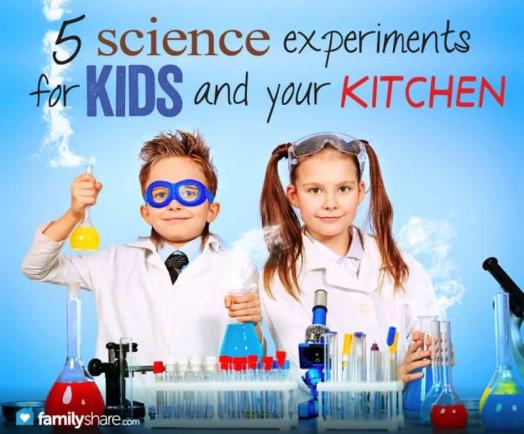
Has your kid asked "Why?" for the 100th time today? Inquiring minds want to know about the world around them. Here are five easy experiments with household items to satisfy your child's scientific curiosity.
1. Will it float?
If your kids wonder why does a heavy oceanliner float while a small pebble sinks, try this experiment that teaches about water displacement. All you need is a bowl of water, molding clay and a few marbles.
-
Drop the marbles into the water - they will quickly sink.
-
Roll the clay into a ball and drop it into the water - it will also sink.
-
Remove the marbles and the clay.
-
Shape the clay to make a shallow "boat."
-
Drop the boat in the water - it now floats.
-
Add a cargo of marbles - it will sink a little, but will still float.
Explain to your kids that whether or not something floats depends not only on the weight, but how much water the object displaces, or pushes aside. See how many marbles your boat will hold and experiment with other materials to see if they float.
2. See plants drinking
Like every living thing, plants are dependent on water. Help your kids see how we are affected by contaminants in the water by changing the color of some flowers. You will need fresh white carnations, a few different colors of food coloring and water filled cups.
-
Put a different color of food coloring into each cup of water.
-
Trim the stems of the flowers and place each in a cup of colored water.
-
Leave the flowers in a warm room.
-
Watch as they change color over the next few days.
-
For extra fun, split the stem of one flower and place it into two different cups - it will absorb both colors.
3. Make a periscope
When a submarine crew wants to see above the waves they use a periscope. Your kids will enjoy using this homemade version to check around corners or over obstacles. You will need a triangle cut from stiff paper, two small mirrors and a tall empty milk or juice carton.
-
Use the triangle to help you draw two lines on one side of the carton.
-
Cut a slot along each line just wide enough for the mirrors to fit into.
-
Cut two slots directly opposite of the mirror slots on the other side of the carton.
-
Push the mirrors all the way into the slots. They should fit snugly.
-
Draw a large square near the top of a third side of the carton opening it up to one mirror.
-
Make a small hole with a pencil on the opposite side of the carton of the square opening near the bottom, level with the second mirror.
-
Look into the hole to see around corners and over obstacles.
4. Tornado in a bottle
This experiment will look like a mini tornado in your kitchen, but it is actually a whirlpool. Explain to your kids that while tornados happen in air, the same principals of a funnel apply in the water making whirlpools. You will need two empty plastic soda bottles, water and tape.
-
Fill one bottle 3/4 full of water.
-
Line up the spouts and tape the other bottle to the top of the bottle with water in it.
-
Turn the bottles over so the one with the water is on top - the water will have a hard time going down.
-
Gently swirl the bottles in a circular motion creating a funnel.
When the water moves fast enough, it pushes out against the bottle and leaves a hole in the middle. There's no water in the hole, only air. Air from the bottom of the bottles comes up and the water goes down.
5. Rock candy
This is a tasty treat that doubles as a science experiment. Your kids can see how crystals grow and make their own dessert. All you really need is sugar, hot water and a string. You can add flavoring and food coloring if you want for a tastier candy. You will need to use the stove for this one, so the kids can't do it alone.
-
Combine 3 cups of sugar and 1 cup of water in a pan.
-
Heat the mixture to a boil, stirring constantly - you want it to hit a boil, but don't boil it for any amount of time. When it hits a boil, immediately take it off the heat.
-
Add any color or flavorings you'd like.
-
Stir until all the sugar has dissolved, then put it in the refrigerator to cool.
-
Tie your string to a pencil or something that can lie across the top of a cup or jar.
-
Soak your string in the syrup mixture you made and hang it to dry.
-
Pour your cooled solution into a clean jar or cup.
-
Hang your string over the top. It should not touch the sides or bottom of the jar.
-
Set the jar aside and watch the crystals grow for three to seven days.
-
Enjoy!
Science in the kitchen is a great way to engage your kids in learning about the world around them. It can also keep kids' minds sharp and chase away boredom during long school breaks. Need some more ideas? Check out these 40 Cool Science Experiments from Scholastic.
This article was originally published on FamilyShare.com. Check out these other related articles: More than a towel: 5 fun activities to do with towels, 6 fun ways to cook with kids and 3 simple kids' crafts you can do with household items.

